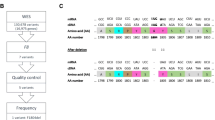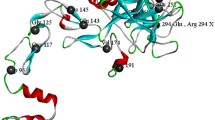Summary
Hemophilia B is due to multiple molecular defects in the factor IX gene. Over 80% of mutations are single base substitutions. By amplification and direct sequencing, 51 single base substitutions were found in the transcribed sequence of the factor IX genes of patients from 50 distinct families with hemophilia B. These include 30 mutations in 29 families not previously reported by us; of these, 12 are novel, i.e., not previously published in other series. Of the 51 substitutions in our overall series 23 (45%) occurred as C-to-T or G-to-A transitions at 11 sites within CG dinucleotides. It is estimated that CG transitions occur from one to two orders of magnitude more frequently than mutations in nucleotides that are not within a CG pair. More than one family had identical defects for 6 of the CG mutations. At 4 of these sites, most patients had different haplotypes compatible with distinct mutations. Non-CG-type mutations occurred thoughout the coding regions with only one mutation in more than one family. The latter included 7 families with a 397 Ile-to-Thr defect that all share a rare haplotype, suggesting a common ancestor.
Similar content being viewed by others
References
Bird AP (1980) DNA methylation and the frequency of CpG in animal DNA. Nucleic Acids Res 8:1499–1504
Bitter K (1964) Erhebungen zur Bestimmung der Mutationsrate für Hamophilie A und B in Hamburg. Z Mensch Vererb Konstitutionslehre 37:251–268
Bottema CDK, Koeberl DD, Sommer SS (1989) Direct carrier testing in 14 families with hemophilia B. Lancet II:526–529
Bottema CDK, Ketterling RP, Koeberl DD, Bowie EJW, Taylor SAM, Lillicrap D, Shapiro A, Gilchrist G, Sommer SS (1990) A past mutation at isoleucine 397 now is a common cause of moderate-mild hemophilia B. Br J Haematol 75:212–216
Bouvier DP, Chen SH, Thompson AR (1990) A 50 bp polymorphic insertion in the factor IX gene is readily detected by amplification and is in equilibrium with other polymorphic sites. Nucleic Acids Res 18:5325
Bray GL, Weinmann AF, Thompson AR (1986) Calcium-specific immunoassays for factor IX: reduced levels of antigen in patients with vitamin K disorders. J Lab Clin Med 107:269–278
Brownlee G (1989) Haemophilia B: a review of patient defects, diagnosis with gene probes and prospects for gene therapy. Recent Adv Haematol 5:251–265
Chen S-H, Yoshitake S, Chance PF, Bray GL, Thompson AR, Scott CR, Kurachi K (1985) An intragenic deletion of the factor IX gene in a family with hemophilia B. J Clin Invest 76:2161–2164
Chen S-H, Scott CR, Schoof J, Lovrien EW, Kurachi K (1989a) Factor IXinPortland: a nonsense mutation (CGA to TGA) resulting in hemophilia B. Am J Hum Genet 44:567–569
Chen S-H, Thompson AR, Zhang M, Scott CR (1989b) Threepoint mutations in the factor IX genes of five hemophilia B patients. J Clin Invest 84:113–118
Freedenberg DL, Chen S-H, Scott R (1989) Factor IX-Seattle 4: a C to T mutation in the second TaqI site of exon VIII in the factor IX gene: detection by PCR amplification and direct sequencing. Am J Hum Genet 45:A186
Geddes VA, Le Bonniec BF, Louie GV, Brayer GD, Thompson AR, MacGillivray RTA (1989) A moderate form of hemophilia B is caused by a novel mutation in the protease domain of factor IXVancouver. J Biol Chem 264:4689–4697
Giannelli G, Green PM, High KA, Lozier JN, Lillicrap CP, Ludwig M, Olek K, Reitsma PH, Goossens M, Yoshioka A, Sommer S, Brownlee GG (1990) Haemophilia B: database of point mutations and short additions and deletions. Nucleic Acids Res 18:4053–4059
Green PM, Montandon AJ, Bentley DR, Ljung R, Nilsson IMJ, Giannelli F (1990) The incidence and distribution of CpG→TpG transitions in the coagulation factor IX gene: a fresh look at CpG mutational hotspots. Nucleic Acids Res 18:3227–3231
Haldane JBS (1935) The rate of spontaneous mutations of a human gene. J Genet 31:317–326
Hirosawa S, Fahner JB, Salier JP, Wu CT, Lovrien EW, Kurachi K (1990) Structural and functional basis of the developmental regulation of human coagulation factor IX gene: factor IX Leyden. Proc Natl Acad Sci USA 87:4421–4425
Koeberl DD, Bottema CDK, Beustedde J, Sommer SS (1989) Functional important regions of the factor IX gene have a low rate of polymorphism and high rate of mutation in the dinucleotide CpG. Am J Hum Genet 45:448–457
Koeberl DD, Bottema CDK, Sarkar G, Ketterling RP, Chen S-H, Sommer SS (1990a) Recurrent nonsense mutations at arginine residues cause severe hemophilia B in unrelated hemophiliacs. Hum Genet 84:387–390
Koeberl DD, Bottema CDK, Ketterling RP, Bridge PJ, Lillicrap DP, Sommer SS (1990b) Mutations causing hemophilia B, direct estimate of the underlying rates of spontaneous germ-line transitions, transversions, and deletions in a human gene. Am J Hum Genet 47:202–217
Reiner AP, Thompson AR (1990) An HhaI polymorphism is present in factor IX genes of Asian subjects. Hum Genet 86:87–88
Saiki RK, Gelfand DHS, Stoffel S, Scharf SJ, Higuchi R, Horn GT, Mullis KB, Erlich HA (1988) Primer-directed enzymatic amplification of DNA with thermostable DNA polymerase. Science 239:487–491
Sanger F, Nicklen S, Couson AR (1977) DNA sequencing with chain-terminating inhibitors. Proc Natl Acad Sci (USA) 74:5463–5467
Thompson AR (1977) Factor IX antigen by radioimmunoassay: abnormal factor IX protein in patients on warfarin therapy and with hemophilia B. J Clin Invest 59:900–910
Thompson AR (1991) Molecular defects in hemophilia B patients. In: Hoyer LW, Drohan WN (eds) Recombinant technology in hemostasis and thrombosis. Plenum, New York, pp 115–131
Thompson AR, Chen S-H, Smith KJ (1988) Diagnostic role of an immunoassay-detected polymorphism of factor IX for potential carriers of hemophilia B. Blood 72:1633–1638
Thompson AR, Brayer GD, Chen S-H (1989) Severe hemophilia B due to a Gt·T transversion changing Gly 309 to val and inhibiting active protease conformation by preventing ion pair formation. Blood 74:134a
Thompson AR, Bajaj SP, Chen S-H, MacGillivray RTA (1990) “Founder” effect in different families with a hemophilia B mutation. Lancet 1:418
Vogel F, Motulsky AG (1986) Human genetics: problems and approaches, 2nd edn. Springer, New York
Wang NS, Chen S-H, Thompson AR (1990a) Point mutations in four hemophilia B patients from China. Thromb Haemost 64:302–306
Wang NS, Zhang M, Thompson AR, Chen S-H (1990b) Factor XinChongquing: a new mutation in the calcium-binding domain of factor IX resulting in severe hemophilia B. Thromb Haemost 63:24–26
Yoshitake S, Schach BG, Foster DC, Davie EW, Kurachi K (1985) Nucleotide sequence of the gene for human factor IX (antihemophilic factor B). Biochemistry 24:3736–3750
Zhang M, Chen S-H, Thompson AR, Lovrien E, Scott CR (1989) CG dinucleotides are “hot spots” in the factor IX gene for point mutations: evidence from the study of 25 families with defined mutations causing hemophilia B. Am J Hum Genet 45:A231
Zhang M, Chen S-H, Scott CR, Thompson AR (1989b) The factor IX BamHI polymorphism: T to G transversion at the nucleotide sequence 561. Hum Genet 82:283–284
Author information
Authors and Affiliations
Rights and permissions
About this article
Cite this article
Chen, SH., Zhang, M., Lovrien, E.W. et al. CG dinucleotide transitions in the factor IX gene account for about half of the point mutations in hemophilia B patients: a Seattle series. Hum Genet 87, 177–182 (1991). https://doi.org/10.1007/BF00204177
Received:
Revised:
Issue Date:
DOI: https://doi.org/10.1007/BF00204177




